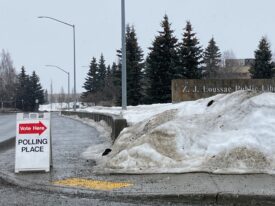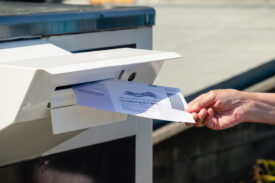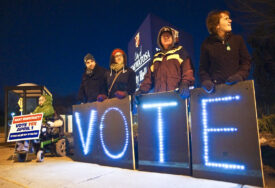Those few members of the public in Washington, and even Oregon, who know anything about ranked-choice voting (RCV) have often heard, vaguely, that it didn’t work in Pierce County a decade ago. But they aren’t really sure what happened, and may draw the wrong lessons. This article sets the story straight about what really happened and what lessons electoral reformers can learn.
In 2006, voters in Pierce County, which surrounds Tacoma, Washington, voted to use ranked ballots in county elections. But in 2009, after just two elections with the new ballots, they reversed themselves and voted to repeal RCV. What went wrong with this electoral reform experiment in the Pacific Northwest?
- Top Two primaries eliminated the case for RCV: Voters passed RCV in large part to avoid pick-a-party primaries for county offices. But then the courts restored Top Two primaries, and the main reason for RCV was gone.
- Implementation was costly: The county had to write new rules, purchase new equipment, and print and count double the usual number of ballots.
- Partisans weren’t happy: Political party players didn’t like the change and jumped at the chance to repeal it.
- Unfortunate winner: The year that Pierce County used RCV was also the first year several county offices became nonpartisan, giving Dale Washam, a perennial candidate with strong name recognition, an advantage. He was the first place candidate in every round, meaning he most likely would have won anyway, but for many voters, his astonishing incompetence stigmatized RCV.
Read on to find more details about what happened in Pierce County, and six lessons reformers can learn.
What really happened #1: Pierce County voted for RCV to escape pick-a-party primaries, but then Top Two primaries got implemented statewide
From 1935 through 2003, Washington voters enjoyed the right to vote in every primary, regardless of party, through the “blanket primary.” In a blanket primary, voters can vote for any candidate regardless of party, and the top candidate from each party advances to the general election. The two major political parties brought legal challenges against blanket primaries in 1935, 1978, and were finally successful in 2003 when the Ninth Circuit Court of Appeals held that Washington’s blanket primary was unconstitutional because it violated political parties’ right to free association. That is, blanket primaries gave Democrats a voice in picking Republican general-election candidates and vice versa, something only party members should have. In 2004, the state legislature passed a “pick-a-party primary” bill requiring voters to choose one party and only vote for that party in partisan primaries.
Washington voters resented the constraints of pick-a-party primaries and swiftly rebelled. In 2004, voters passed Initiative 872, a measure that would replace pick-a-party primaries with Top Two primaries, a solution that allowed voters to ignore parties without violating the constitution in the way blanket primaries did. Top Two allows all voters to vote in a single primary and the top two vote-getters advance to the general ballot, no matter their party. But a federal court struck it down before it could be used, so voters were forced to use pick-a-party primaries in 2004.
Pierce County voters chafing under pick-a-party primaries saw an escape option in Ranked Choice Voting (RCV). In a single high-turnout election in November, voters could rank any candidates they wanted, regardless of party. Votes would be counted in rounds, candidates with the fewest votes would be eliminated (just as they would have been in a primary) and votes re-counted until one candidate won a majority of active ballots. In 2006, the charter review commission narrowly agreed to put RCV on the ballot. The campaign told voters to vote yes on the amendment to get rid of pick-a-party primaries. Pierce County voters embraced this message and voted to pass the charter amendment. The amendment eliminated the primary for county councilors, executive, sheriff, auditor, and assessor-treasurer. Starting with the November 2008 general election, parties could indicate the candidates they endorsed and voters could rank all candidates, regardless of party.
But Pierce County’s escape from pick-a-party primaries was moot before it began. In 2008, the Supreme Court of the United States reversed the lower court and upheld Washington’s Top Two primaries initiative. The state implemented it in the 2008 primary, the same year that Pierce implemented Instant Runoff Voting. With pick-a-party primaries gone, Pierce voters didn’t know why they needed RCV.
What really happened #2: Pierce County paid more because many RCV resources had not yet been developed
The county had to print two ballots
Instead of printing a single ballot with both RCV and other races, like Burlington, Vermont, did in 2006, Pierce County’s election machines vendor, Sequoia, claimed it had to print two separate ballots—one for the county’s ranked elections and another for all other elections (sample below). This increased printing costs, mailing costs, and polling place costs. It also annoyed voters, who had to deal with two separate ballots, and had to wait in longer lines at polling places as poll workers processed double the necessary number of ballots.

Ranked choice voting ballot by Pierce County Elections (license)
The Auditor had to pay for things she would not have to do today
To figure out how to implement RCV, the Auditor’s office hired two new staff, paid an election consultant, conducted an internal legal review, formed a blue ribbon panel, presented 11 actions to the County Council and four charter amendments to voters. Thankfully, all that would be easier for a jurisdiction implementing RCV today. Today’s Auditor could just look at the Ranked Choice Voting Resource Center’s resources on how to conduct an RCV election, including how to write the statute, how to negotiate with the vendor, and best practices for designing the ballot and educating poll workers and voters.
The Auditor also hired 114 people to transport the 52,000 ballots that were cast at polling places in 2008. Today, all Oregon and Washington voters mail their ballots to the county so there would be no need to transport ballots in a city or county election.
Finally, the Auditor had to pay for new equipment and for the county’s equipment vendor to write a new software module to count ranked ballots. Today, Washington state has certified four systems that are RCV-ready (can already count an RCV ballot) or RCV-capable (can count an RCV ballot with a software module). Nine of Washington’s 39 counties use RCV-ready or -capable equipment, or hardware that could use certified RCV-ready software. Although costs will vary by county and system, RCV software modules now cost on the order of $25,000 and a new software system costs on the order of $200,000. Another 26 Washington counties have outdated equipment that may need to be replaced soon. When they are spending money on new equipment, those counties could simply choose certified RCV-ready equipment.
However, she probably overspent
Auditor Pat McCarthy, who opposed RCV during the 2006 campaign, spent an eye-popping $1.6 million to implement RCV in 2008. She did not detail how much she spent on new equipment, the RCV software module, and voter education, but those three costs together added up to $857,025. Comparing to recent estimated costs for RCV implementation in the State of Maine, new equipment would cost $75,000, an RCV module $25,000, and voter outreach $50,000 for a grand total of $150,000. As another point of comparison, the city of Cary, North Carolina spent just $10,000 to successfully educate its 110,000 residents about RCV. McCarthy’s ongoing costs of $769,773 for printing and mailing the additional ballots, and hiring and training staff also seem very high. Maine, with twice as many voters as Pierce County, estimates printing costs of $230,000 for an additional RCV ballot.
In the 2008 RCV election, McCarthy was elected to County Executive. In 2009, a committee appointed Republican Jan Shabro, who was promising to repeal RCV, to fill the post. Shabro implemented the 2009 RCV election, and appears to have incurred similarly high costs.
She didn’t count the savings
Eliminating four primary races saved the county more than $1.2 million in 2008.
Neither Pat McCarthy nor Jan Shabro counted any savings from eliminating unnecessary primary races. It costs money to run a primary race, even if the costs are not a budget line for the county. Cities and Ports reimburse counties for each item on the ballot, and if their reimbursements are a reasonable facsimile of the additional cost to the county for each ballot item, we can estimate that each primary race cost Pierce County more than $300,000, so eliminating four primary races saved the county more than $1.2 million in 2008. That’s almost enough to offset their bloated RCV budget, and enough to save the county hundreds of thousands of dollars in every subsequent RCV election after the one-time costs were paid.
She didn’t tell voters why they were using RCV
Because they were seeing two new voting systems at once (RCV and Top Two primaries) voters needed context on the reasons for using them. The voter’s pamphlet could have explained that RCV eliminated unnecessary primaries while still giving voters a chance to voice their opinion about more than one candidate. Instead, the explanation was mechanical and confusing.
Voters didn’t like the double ballots nor the costs
Perhaps due to the confusion of starting two new systems—Top Two primaries and RCV—at the same time, or because of the cumbersome second ballot, or because they had heard about the exorbitant costs, voters did not like RCV. The Auditor sent a survey to 440,000 voters and received nearly 91,000 back, with 66 percent saying they did not like the new Ranked Choice Voting system, and just 34 percent saying they did like it. This was an unusual result—every other poll of RCV voters shows a majority support the system. Some of the negative comments were:
- “Don’t waste paper.”
- “A useless endeavor and a waste of money.”
- “Too complicated.”
- “Keep the voting simple. Stop trying to fix what isn’t broken.”
What really happened #3: RCV worked
It attracted more candidates and eliminated the wasteful primary
All eight of the ranked races in 2008 and 2009 attracted at least two candidates, and five attracted three or more. In the races with more than two candidates, the ranked ballots did their job. For example, in the 2009 race for County Auditor, Independent Julie Anderson had 49.9 percent of first-rankings and Republican Jan Shabro had 41 percent. Once Will Baker was eliminated, Anderson won with a clear majority—56 percent. Ranked voting efficiently found a majority winner in a single high-turnout election.
This was an improvement on previous Pierce County elections. In 2004 and 2006, only one of the ten county elections attracted more than two candidates, four of them had only one candidate, and another had only Democrats in the primary, so general election voters saw only one option. The county paid to run unnecessary primary elections when only one or two candidates were on the ballot to begin with, and voters often had no choices.
It allowed candidates with less money to win
In 2004, in five of six county races the candidate who outspent their opponent won. In the 2008 RCV elections, only three of the six biggest spenders won.
But partisans weren’t happy
The 2008 RCV race elected Democrat Pat McCarthy to become Washington’s first female County Executive. In the four-candidate race, Republican Shawn Bunney had 35 percent of first-ranked votes and Democrat Pat McCarthy had 26 percent, but when the two less popular candidates were eliminated and the votes (instantly) recounted, McCarthy won with a majority of active ballots. Republicans weren’t happy that their candidate, after initially being in the lead, lost. Some Democrats may have been disappointed that Calvin Goings, the Democrat with stronger party support, lost.
Dale Washam, after building name recognition for years, won in a newly nonpartisan race
Dale Washam, a nightmare for Pierce County, won the Assessor-Treasurer position in 2008. The position was listed as nonpartisan for the first time, creating an advantage for the candidate with the most personal name recognition since voters had no party information to guide them. Washam built name recognition for more than a decade by regularly running for office and maintaining permanent highway signs with his name. He ran in 1994 and 1996, and in 2000, 2002, and 2004 he came close to winning, getting more than 40 percent of the vote for Assessor-Treasurer or Auditor. Washam was listed first of six candidates for Assessor-Treasurer, none of whom did much campaigning.
RCV wasn’t the reason Washam won—he was in first place in every round of counting, so he definitely would have won under plurality voting and most likely would have won with a Top Two primary (unless his opponent stepped up and ran an effective campiagn to discrecit Washam between the primary and general).
Nonetheless, some voters blamed ranked choice voting for Washam’s win.
What really happened #4: power players pushed for repeal
In 2009, a majority of County Council (all members of the two major political parties) placed an RCV repeal initiative on the ballot. Voters, fed up with the double ballots and added expense and hearing a stream of criticism from political leaders, overwhelmingly voted to repeal RCV and use the newly-instated Top Two primaries to elect county officers.
The real lessons from Pierce County
Now that we’ve got the facts straight, Pacific Northwesterners looking for a better democracy can think clearly about the real lessons learned, and how the Pierce County experiment can inform future campaigns.
Lesson 1: Reform needs to provide big, lasting benefits that voters care about
Voters cared about getting rid of pick-a-party primaries. But once the courts reinstated Top Two primaries, voters didn’t know why they should support RCV.
Future reformers should first identify the big problems reforms will solve for years to come. Then, make sure the campaign has the allies and resources to keep letting voters know about those benefits, year after year.
Lesson 2: Work with the Auditor and the major parties in advance
The two major parties often oppose RCV, seeing it as a threat to their domination of American politics. They can then wield power to kill reforms, as both Democrats and Republicans in the Auditor’s office and the County Council did in Pierce County. Even if she isn’t motivated by party affiliations, if the Auditor feels she doesn’t have the resources she needs to write the rules and implement the system well, she may oppose it.
Electoral reform advocates might be able to avoid another Pierce County experience by reaching out to local major party players in advance to find allies who will support reforms, or neutralize opposition. Reformers should also reach out to auditors to familiarize them with the resources available to help smoothly implement RCV without re-creating the wheel.
Lesson 3: Use best practices when implementing RCV
The RCV Resource Center offers best practices advice on statutory language, ballot design, voter outreach, and more. Other Pacific Northwest jurisdictions can avoid unnecessary double ballots and wasted implementation costs by using these resources.
Lesson 4: Avoid big costs
Reformers in jurisdictions with outdated equipment may want to avoid forcing equipment upgrades solely for RCV elections. Instead, they could require that any new equipment be RCV-ready. That way the costs of RCV-readiness are built into necessary updates, instead of being an extra cost that can be pinned on RCV alone. A county without the necessary equipment could contract with a nearby equipped county to count RCV ballots until the county upgrades its own equipment.
Lesson 5: Count the savings
When implementing reform in cities and ports, advocates should point to the clear savings for taxpayers from eliminating primary elections. Because counties don’t have a budget line item for primary election costs, the way cities and ports do, it will be important for advocates to calculate and advertise the county’s savings from eliminating a primary election.
Lesson 6: Keep working even after reform passes
Just like we learned from Burlington, Vermont, Pierce County teaches reformers that it’s not over when the ballot initiative passes. Pierce County had some remarkably dedicated backers, like Kelly Haughton who wrote a regular blog about RCV, but the reform needed a bigger groundswell of support. Reformers need to keep working with the Auditor and the two major parties to head off sabotage, and keep working with voters to remind them why they passed RCV in the first place, what problems it solves, and how it is working.











Will
As a Pierce County activist, I really appreciate having this article. It collects all the important details in one place.
Steve
I know a lot some things about Ranked voting in Pierce County –
It produced Dale Washam !
It didn’t work and it wont work in Seattle !
Fix Democracy and Sighline our part of our problem.
Steve
You can come up with all that stuiff.
But still remember this the Voters Voted down Ranked Voting and will
go down big in Seattle. No matter what you spend on this one Sightline.
You think Cindy Black has a problem – she thinks fix democracy has a solution
to every problem. But the voters don’t think it is a problem.
Ben
Steve, the fact that Washam won most first-round preferences *and* won run-off IRV makes it hard to point to IRV as causing his election. Maybe the information landscape for voters would have been different in a top-two primary situation, with only two candidates on the final ballot, but the math alone hardly suggests IRV was responsible for his election.
Steve
Also somewhere in State Law it say Charter Admendments cant be on the ballot
in Non City Election years. I wonder why you people r trying to put it on the
ballot next year in Seattle. I dont want to walk into the polls and have 2 systems
on how I pick my candidates on the ballot.
TW
I don’t think you read the article, did you Steve?
todd
Ranked choice voting will allow for more choices while making sure that the candidates elected are supported by a true majority of voters.
Matt Temmel
Gosh, interesting article, but I think it is really far from the truth. Confuses election mechanics and costs, and says that voters later got rid of RCV for those reasons–whereas in fact the main driver was that voters were very aware that RCV had elected Dale Washam and thought that plural voting didn’t make a lot of sense. We were raised to select the best choice, not to say which candidate is second best or third best, and so voters repealed the RCV system that they had previously authorized a short time earlier. The voters were right, I say.
RCV is being sold in the US as an answer to partisan politics, and it is no such thing. I think RCV makes sense in multi-member constituencies, such as an Irish parliamentary district in which two candidates are to be elected, and each voter has a “single transferable vote.” Look it up and study it. It makes sense. But having multiple transferable votes (as in almost all US ranked choice elections) does not—it is electoral anarchy.
The advocates of RCV in the US are, basically, importing and changing a system invented in Europe for parliamentary elections and applying it, in most cases, to elections with only one winner. That is bad history and bad political science.